The ASUS ROG Strix GL502VS Review: Mainstream GTX 1070 with G-SYNC
by Brett Howse on December 9, 2016 8:00 AM ESTSystem Performance
At this point the Skylake mobile quad-core parts are pretty well known. The review unit is outfitted with the Intel Core i7-6700HQ, which is a 45-watt 2.6-3.5 GHz CPU. It has been the staple of almost all quad-core notebooks this year. Also the review unit is outfitted with just a single stick of 16 GB DDR4-2133 memory, which will hamper performance a bit over a dual-channel setup in some of the more varied tests such as PCMark. It’s not quite as critical though on a notebook with a dedicated GPU, but still it would be nice to see 2x8 GB rather than 1x16 GB, unless you wanted to upgrade, in which case the single 16 GB is likely the better choice.
The ASUS GL502VS was put through our standard notebook workflow, which includes a variety of tests to stress different aspects of the device. Several other similar models are used as a comparison, but if anyone wants to compare the GL502VS to any other notebook we’ve tested, please use our online bench.
PCMark
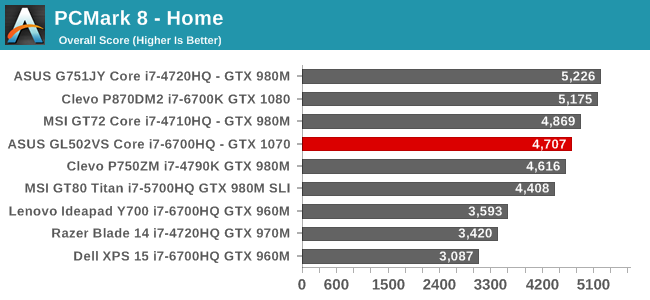

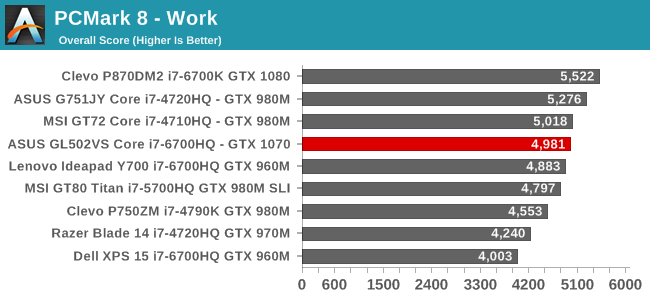
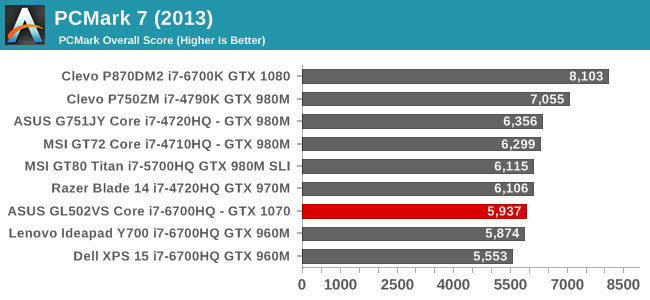
PCMark from FutureMark is a comprehensive system test, which runs through a variety of workloads based on the test chosen. All aspects of the machine impact the final results, including GPU, CPU, memory, drive speed, and even display resolution. The ASUS scores very well here, despite single channel memory performance. The Creative score is quite strong thanks to the much more powerful GPU than previous generation notebooks.
Cinebench

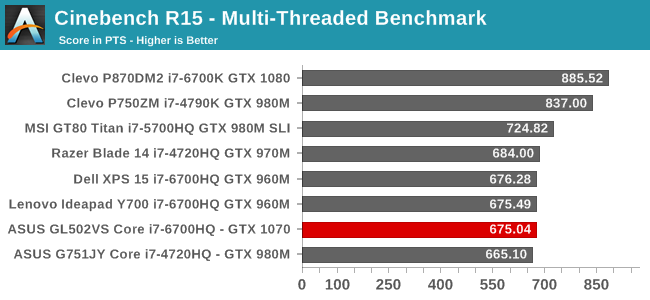
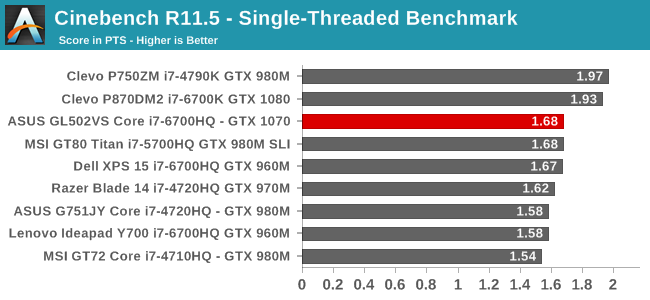
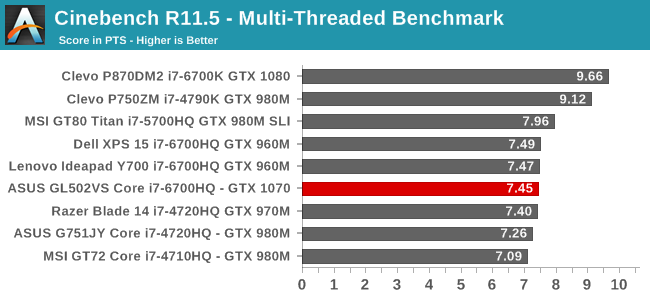
Cinebench is a rendering program which is a pure CPU test. More cores and a higher frequency can pay big dividends on this test. The i7-6700HQ is right in line with other devices with the same CPU.
x264
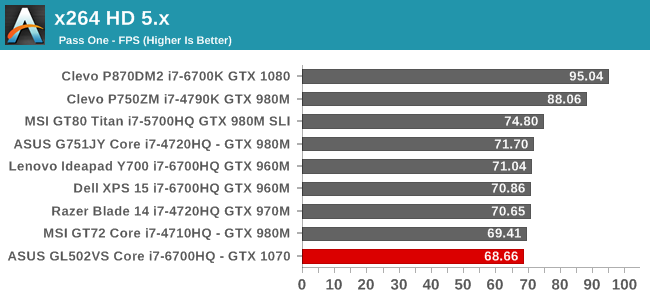
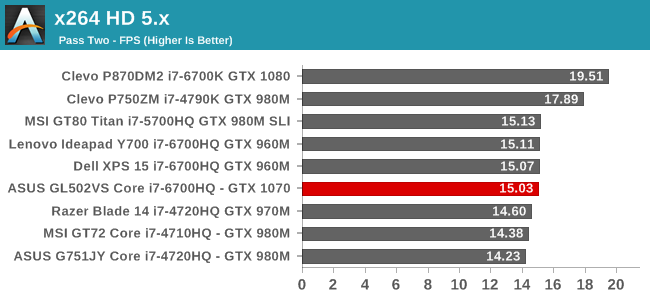
Like Cinebench, this test is mostly a CPU bound test, and once again, the ASUS falls in-line with the other quad-core notebooks featuring this CPU. The desktop class CPUs in the Clevo notebooks have a large advantage on these tests.
Web Tests
The browser is likely the most used application on any computer, and as such browser performance is always important. We’ve moved to Microsoft Edge as the browser with the release of Windows 10, and like Google Chrome and other browsers, the performance of the scripting engine generally improves over time. Each browser performs better on some tasks than others, so these tests have the browser used on each unit pointed out in the results.
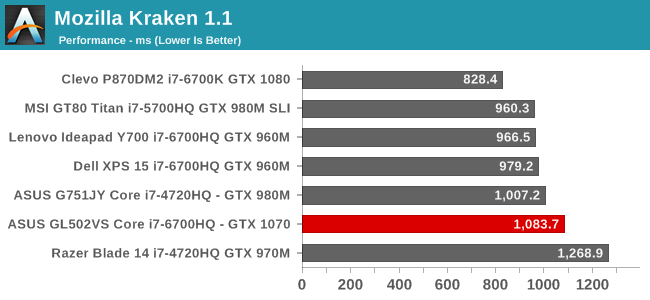
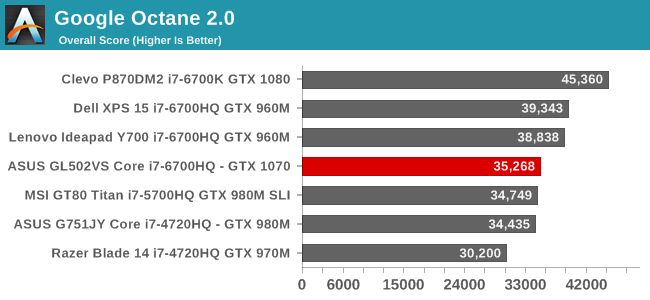
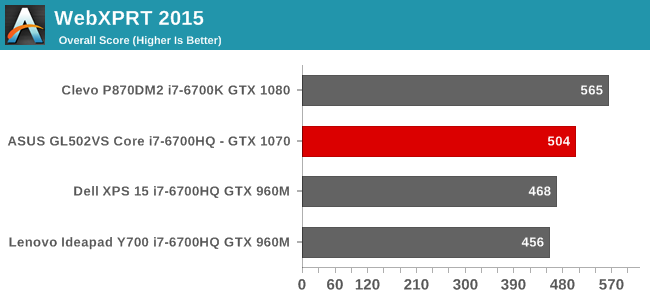

The i7-6700HQ continues to be a strong performer in these tests. The desktop i7-6700K in the Clevo P870DM2 is much quicker, but it’s also a 95-Watt CPU.
Storage Performance
There has been a big push the PCIe based storage over the last twelve months, and ASUS has definitely been at the forefront of that movement. But as we know, not all NVMe drives are the same. NAND capacity is always a factor, and of course TLC or MLC can be a big impact, especially on write speeds where TLC struggles. The ASUS review unit shipped with the Samsung SM951 SSD, which is (unusually for this level of device) an MLC drive. This was already hinted at earlier, but ASUS saved some money on the design of this notebook, but they continue to pack in quality hardware inside, and the use of the SM951 has to be commended since it’s unfortunately very rare to see over the TLC based PM951.
Being just the 256 GB version, the fewer NAND dies compared to the larger capacity models is really the only issue with performance, but it performs very well regardless. Even random read and write speeds are quite strong.
It’s great to see this drive in what would otherwise be considered a budget laptop. Too many laptops, even much more expensive than this one, ship with TLC drives, which are fine, but when you are paying a premium you should expect better.


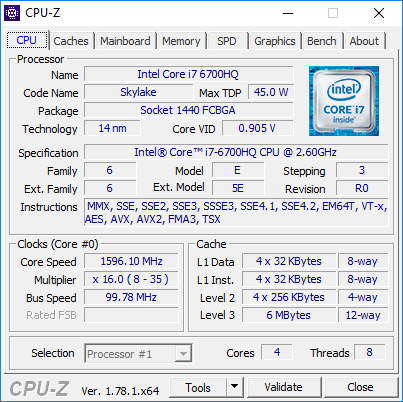
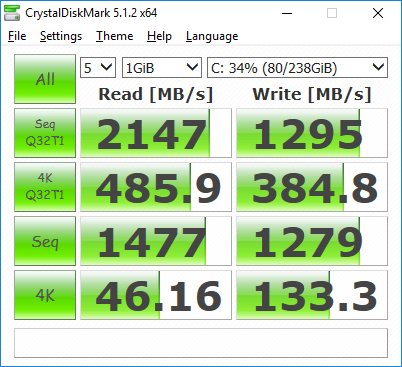








54 Comments
View All Comments
nathanddrews - Friday, December 9, 2016 - link
Is $1600 mainstream?Hopefully we see FreeSync (or G-Sync) laptops on the "low end" $800 laptops. Seems like a ripe market for Adaptive Sync technologies, given the lesser performance of GTX 960m and similar parts.
close - Friday, December 9, 2016 - link
Given the prices I saw recently on deeply flawed (unbalanced) gaming machines, ~$1600 for something that comes with more than decent CPU, GPU and SSD might as well be called mainstream. The rest is still compromised as opposed to a proper gaming machine (small screen, integrated keyboard and touchpad) but at least you get a reasonable package for a relatively reasonable price.Do not compare it to a desktop. The desktop will still be twice as cheap and a lot more powerful for a long time.
xenol - Friday, December 9, 2016 - link
Find me a complete desktop system (that includes all of I/O) that performs about the same for half the cost.sorten - Friday, December 9, 2016 - link
It would be difficult to find a comparable desktop for the comparison. You could probably go with an i5 65W CPU and it would significantly outperform the laptop's 45W i7. The 1070 is the same for desktop and mobile, but much more thermal headroom on the desktop. Memory and SSDs are cheap. I also wouldn't count the cost of the monitor in the comparison, because the only time I wouldn't dock the laptop so I could use my 27" monitor would be in the rare trip to a hotel or similar place.The other thing is that anyone who is building a desktop for gaming is only replacing one or two components. For example, I could build a faster desktop gaming system than this laptop by just spending the $400 on the GPU. I've had the same case, PSU, optical drive, etc. for probably 7 or 8 years.
Samus - Sunday, December 11, 2016 - link
The other thing to keep in mind is you can build a mini ITX system with an i7 and GTX1070 while still being incredibly tiny, less expensive and more capable (aside from being slightly more bulky and lacking battery power.)But that's the real killer with gaming laptops. Unless they are DTR's, they are too weak in graphics performance, and when they are DTR's, battery life is a joke anyway.
close - Tuesday, December 13, 2016 - link
@xenol, if it's any easier for you to understand read it as "performance/$". Or do you specifically want me to lookup some desktop CPUs/GPUs that are gimped by thermal headroom to match the equivalent laptop ones, a case that allows for close to 0 upgradeability, a 15" mediocre screen, crappy keyboard, integrated buzzers... erm, speakers, and a touchpad instead of a mouse?I was talking more of a hypothetical equivalent since it's hard to build a desktop that matches *any* gaming laptop in compromises. Yeah, I get that if you want portability a laptop is the way to go. It's still a severely compromised machine, it's still extremely expensive for the hardware but maybe the difference is how much "portability" costs.
Donny2005UK - Wednesday, January 11, 2017 - link
https://www.amazon.com/Lenovo-Ideacentre-Y700-Desk... Sorry cheapest I could find with a decent cpumrmcmurren - Wednesday, February 1, 2017 - link
hey if you are intested i am selling my desktop with better specs for a great price 1200email me at mrmcmurren@gmail.com
specs as follows
BLUETOOTH: None
CASUPGRADE: None
CD: 24X Double Layer Dual Format DVD+-R/+-RW + CD-R/RW Drive (BLACK COLOR)
CD2: None
COOLANT: Standard Coolant
CPU: Intel(R) Core� i7-3820 Quad-Core 3.60 GHz 10MB Intel Smart Cache LGA2011 (All Venom OC Certified)
CS_FAN: Maximum 120MM Color Case Cooling Fans for your selected case
FA_HDD: None
FAN: Asetek 510LC Liquid Cooling System 120MM Radiator & Fan (Enhanced Cooling Performance + Extreme Silent at 20dBA) (Single Standard 120MM Fan)
FLASHMEDIA: None
GLASSES: None
HDD: 2TB (2TBx1) SATA-III 6.0Gb/s 64MB Cache 7200RPM HDD (Single Drive)
HDD2: None
IEEE_CARD: None
MEMORY: 16GB (4GBx4) DDR3/1866MHz Quad Channel Memory (Corsair Vengeance [Free upgrade from 1600MHz Major Brand])
MONITOR: None
MONITOR2: None
MONITOR3: None
MOTHERBOARD: (3-Way SLI/CrossFireX Support) ASUS P9X79 LE Intel X79 Chipset Quad Channel DDR3 ATX w/ Remote GO!, 7.1 HD Audio, GbLAN, 3 Gen3 PCIe X16, 2 PCIe X1 & 1 PCI
NETWORK: Onboard Gigabit LAN Network
OS: Microsoft(R) Windows 8 Pro (64-bit Edition)
OVERCLOCK: No Overclocking
POWERSUPPLY: 800 Watts - Standard Power Supply - SLI/CrossFireX Ready
SOUND: HIGH DEFINITION ON-BOARD 7.1 AUDIO
SPEAKERS: None
TEMP: None
TUNING: None
TVRC: None
USB: None
USBFLASH: None
USBHD: None
USBX: None
VIDEO: GTX 1070 AMP Mini
JoeyJoJo123 - Friday, December 9, 2016 - link
Desktop PCs are cheaper, and are more serviceable, and you avoid the pitfalls of going with a prebuilt system loaded with adware, or in the worst case with Lenovo's Superfish, blatant malware. However, I think you're overestimating the cost of PC ownership, and assume that a complete PC system with peripherals is _half_ the cost of a gaming laptop.GTX 1070 laptop video cards are very roughly comparable to desktop GTX 1070 performance, and Nvidia's gone a long way to help bridge the gap between mobile and desktop class performance. A balanced GTX 1070 PC build will cost ~$1000, with no peripherals or OS. Add in a basic 1080p monitor, mouse, keyboard, etc. and you're at $1250 or so. So the $1600 laptop isn't a farcry from what PC build enthusiasts would claim.
You pay about a 25% premium, I'd think for the compactness and convenience of a fully ready platform. But given that time is a resource, it's not an unjust cost for people who just want a system to be ready without the hassle of the PC building research, parts acquisition, and assembly.
These days prebuilt systems are cheaper than ever, so the argument that building your own PC saves a lot of money is losing its argument. I still do it as it's a fun hobby for me, but I know it's not for everyone.
xenol - Friday, December 9, 2016 - link
I'm poking fun of the desktop fanboy that every time they say "I can make a desktop build for cheaper!" they seem to fail to remember a laptop is a complete system. I'm all for price comparing, but please, make it as apples to apples as possible.It's like every time someone goes "I can make a $400 PC that can best a PS4" fails to account for the fact a PS4 also comes with a $60 controller and a BD drive. I mean, as a pure gaming machine, maybe. But at the same time, if I wanted something that could replace the PS4 as much as possible, I need that BD drive.
I mean, I didn't buy a PlayStation just to play games. I bought it because it's also a media player.